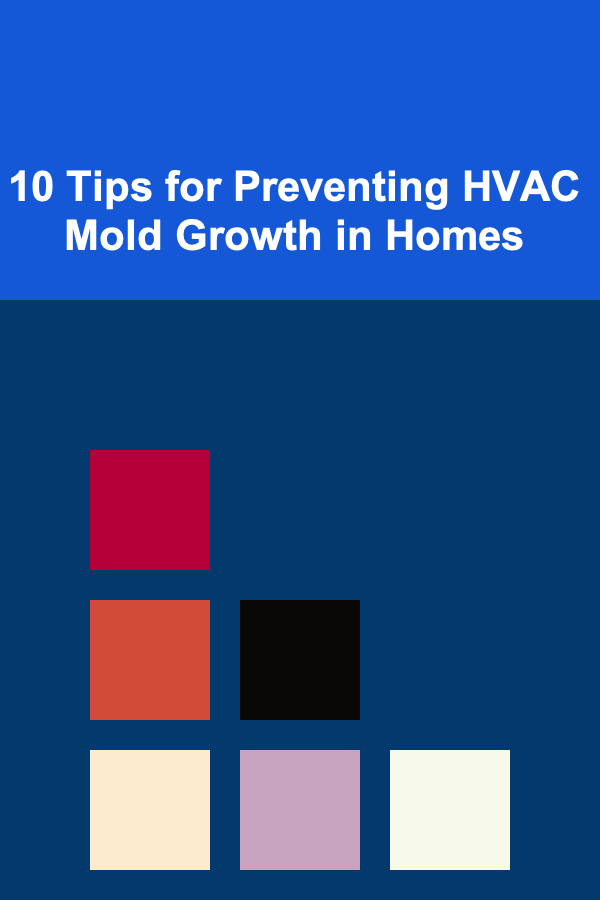
10 Tips for Preventing HVAC Mold Growth in Homes
ebook include PDF & Audio bundle (Micro Guide)
$12.99$7.99
Limited Time Offer! Order within the next:

Mold growth is a common issue in homes, especially in areas with high humidity and poor ventilation. One of the most overlooked places where mold can thrive is within the HVAC system. HVAC (Heating, Ventilation, and Air Conditioning) systems are designed to regulate temperature, humidity, and airflow within a home, but they can also create the perfect environment for mold growth if not properly maintained. The warm, damp conditions inside HVAC systems can provide an ideal breeding ground for mold spores, which can then spread throughout your home, affecting indoor air quality and potentially causing health issues.
In this article, we'll explore 10 essential tips for preventing HVAC mold growth in your home. By implementing these strategies, you can reduce the risk of mold development, improve indoor air quality, and maintain a healthier living environment.
Keep Your HVAC System Clean
Regular cleaning of your HVAC system is one of the most effective ways to prevent mold growth. Mold spores thrive on dust, debris, and other organic materials, so it's essential to ensure that your system remains clean.
Steps for cleaning:
- Air filters: Change your air filters regularly, ideally every 1 to 3 months. Dirty filters can trap moisture and particles that mold can feed on.
- Coils and drains: Clean the evaporator coils and condensate drain of your air conditioning unit to prevent moisture buildup. This is where mold can develop if the system isn't properly cleaned.
- Ductwork: Have your air ducts cleaned periodically, especially if you live in a humid climate or have had water damage.
By keeping your HVAC system free of dust and debris, you reduce the chances of mold spores finding a place to grow.
Control Indoor Humidity Levels
Mold thrives in environments with high humidity, so maintaining proper humidity levels inside your home is crucial in preventing HVAC mold growth. Ideally, the indoor humidity level should be between 30% and 50%. High humidity levels can cause condensation within the HVAC system, providing an environment conducive to mold growth.
Tips for controlling humidity:
- Use a dehumidifier: If you live in a humid area, consider using a dehumidifier to help reduce moisture levels.
- Proper ventilation: Ensure proper ventilation throughout your home, especially in areas prone to high humidity, such as bathrooms, kitchens, and basements.
- Monitor humidity: Use a hygrometer to monitor the humidity levels in different rooms of your home. If the humidity exceeds 60%, take steps to lower it.
By maintaining balanced humidity levels, you can reduce the risk of moisture accumulation inside your HVAC system and prevent mold from taking hold.
Ensure Proper Drainage
A well-functioning drainage system is essential for preventing mold growth in your HVAC system. The condensate drain in your air conditioning unit is designed to remove moisture from the system. However, if this drain becomes clogged or malfunctioning, moisture can accumulate and create ideal conditions for mold to grow.
Tips for ensuring proper drainage:
- Check for blockages: Regularly inspect the condensate drain for blockages. Clear any debris that may be obstructing the flow of water.
- Ensure proper slope: Ensure that the drain line is sloped properly to allow for efficient water drainage.
- Use a wet vacuum: If the drain becomes clogged, use a wet vacuum to clear it. This can help prevent water buildup inside the system.
Proper drainage is essential for preventing moisture accumulation and mold growth. If you're unsure about the condition of your HVAC drainage system, it's a good idea to call a professional HVAC technician for an inspection.
Install a UV Light in Your HVAC System
UV (ultraviolet) lights are an effective tool for preventing mold growth in HVAC systems. UV light works by killing mold spores and other microorganisms that may be present in your system, preventing them from spreading throughout your home.
How UV lights help:
- Kills mold spores: UV light can break down the DNA of mold spores, preventing them from reproducing and growing.
- Prevents bacteria buildup: In addition to mold, UV lights can help reduce the buildup of bacteria and other pathogens in your HVAC system.
- Improves air quality: UV lights help improve indoor air quality by reducing the number of airborne contaminants in your home.
Installing UV lights in your HVAC system can be a proactive step in preventing mold growth and maintaining clean air. Consult with an HVAC professional to determine the best location for UV light installation.
Ensure Proper Ventilation
Proper ventilation is essential for reducing moisture levels and preventing mold growth. Without sufficient airflow, areas inside your home and HVAC system can become stagnant, increasing the likelihood of mold formation. Ventilation helps remove excess moisture, allowing the system to function more efficiently.
Tips for improving ventilation:
- Ventilate high-humidity areas: Make sure rooms like kitchens and bathrooms are properly ventilated to remove excess moisture. Use exhaust fans and open windows when cooking or showering.
- Use vents and registers: Ensure that vents and registers are not blocked, allowing air to flow freely through your HVAC system.
- Check ductwork: Make sure that air ducts are properly sealed and insulated to prevent moisture from entering the system.
Good ventilation is critical for maintaining healthy indoor air quality and preventing HVAC mold growth.
Use Mold-Resistant Insulation
Mold-resistant insulation is designed to prevent mold growth by reducing the chances of moisture buildup inside your HVAC system. This type of insulation is made with materials that are less prone to absorbing moisture, which helps prevent the development of mold and mildew.
Benefits of mold-resistant insulation:
- Reduces moisture buildup: Mold-resistant insulation helps prevent moisture from accumulating in your HVAC system.
- Improves energy efficiency: This type of insulation can help improve the energy efficiency of your system by reducing heat loss.
- Durability: Mold-resistant insulation is often more durable than standard insulation, reducing the need for frequent repairs.
If you're in the process of installing or upgrading your HVAC system, consider opting for mold-resistant insulation to reduce the risk of mold growth.
Regularly Inspect the HVAC System
Routine inspections of your HVAC system are essential for identifying any potential issues before they turn into bigger problems. Regular inspections can help detect signs of mold growth, leaks, or other moisture-related problems that could lead to mold development.
What to look for during an inspection:
- Signs of mold: Look for visible mold growth or musty odors around the system or in the ducts.
- Leaks or water damage: Check for leaks around the air conditioning unit, ducts, and condensate drain.
- Excess moisture: Look for any areas of the HVAC system that appear damp or wet.
By catching issues early, you can take corrective action to prevent mold from spreading in your HVAC system.
Maintain a Clean Environment Around Your HVAC Unit
The area around your HVAC unit plays a role in the overall health of the system. Keeping this area clean and free of debris is essential for preventing mold growth. Leaves, dirt, and other organic matter can easily find their way into the system, providing a food source for mold.
Tips for maintaining a clean environment:
- Clear the area: Keep the area around your HVAC unit clean and free of leaves, dirt, and other debris.
- Seal the unit: Make sure the HVAC unit is properly sealed to prevent outside moisture and contaminants from entering the system.
- Inspect regularly: Check the area around your HVAC unit for any signs of moisture or mold growth.
A clean environment helps reduce the risk of mold growth inside your HVAC system and promotes optimal performance.
Address Water Leaks Promptly
Water leaks are one of the primary causes of mold growth in HVAC systems. If water leaks inside the system, it can lead to moisture buildup and provide an ideal breeding ground for mold. Addressing water leaks promptly is essential for preventing mold growth.
How to address leaks:
- Inspect for leaks: Regularly check the HVAC system for any signs of water leaks, such as puddles or damp spots around the unit.
- Repair leaks immediately: If you detect a leak, have it repaired immediately to prevent moisture from accumulating in the system.
- Check for external leaks: Inspect pipes and ducts connected to the HVAC unit for leaks that could introduce moisture into the system.
Fixing leaks promptly helps maintain the efficiency of your HVAC system and prevents mold growth.
Consider Professional HVAC Maintenance
While regular DIY maintenance is important, it's also a good idea to schedule professional HVAC maintenance at least once a year. A professional technician can thoroughly inspect the system, clean components that are difficult to reach, and identify potential issues that may contribute to mold growth.
Benefits of professional maintenance:
- Expert cleaning: Technicians can clean areas of the HVAC system that are hard to reach, reducing the buildup of dust and moisture.
- Thorough inspections: A professional can conduct a more thorough inspection of the system, looking for potential mold or moisture problems.
- System optimization: A technician can optimize the performance of your HVAC system, ensuring it operates efficiently and doesn't create conditions that promote mold growth.
Investing in professional maintenance can help prevent mold growth and ensure your HVAC system runs smoothly.
Conclusion
Mold growth in HVAC systems can have serious consequences for your home's air quality and your health. By following these 10 tips, you can significantly reduce the risk of mold development in your HVAC system. Regular cleaning, controlling humidity levels, ensuring proper ventilation, and addressing issues promptly are all essential strategies for keeping mold at bay.
If you're unsure about the condition of your HVAC system, consider seeking the help of a professional to ensure that it is properly maintained. By taking proactive measures, you can maintain a mold-free HVAC system and enjoy a healthier, more comfortable home environment.
Reading More From Our Other Websites
- [Home Budget Decorating 101] How to Create a Warm and Inviting Home on a Budget
- [Soap Making Tip 101] Charcoal-Infused Luxury: Crafting Your First Activated Charcoal Soap
- [Home Storage Solution 101] How to Organize Your Home's Entryway for Better Storage
- [Home Cleaning 101] How to Get Your Home Ready for Guests in a Flash
- [Organization Tip 101] How to Organize Your Garden's Fencing and Supports
- [Organization Tip 101] How to Create a Craft Supply Donation Box
- [Skydiving Tip 101] From A-Dropzone to Full License: The Essential Training Timeline Explained
- [Home Staging 101] How to Stage a Home for the Winter Season
- [Organization Tip 101] Why You Should Involve the Whole Family in Organization Projects
- [Personal Care Tips 101] How to Experiment with Bold Blush Colors for a Statement Look

How to Create a Harmony Between Function and Aesthetics
Read More
How To Discover Breakthroughs in Vision Restoration
Read More
Supporting Wildlife Corridors Globally: A Deep Dive
Read More
10 Stunning Quilled Mandala Designs to Try
Read More
10 Tips for Improving Volleyball Serve Receive
Read More
10 Tips for Advanced Interviewing Techniques in Policing
Read MoreOther Products

How to Create a Harmony Between Function and Aesthetics
Read More
How To Discover Breakthroughs in Vision Restoration
Read More
Supporting Wildlife Corridors Globally: A Deep Dive
Read More
10 Stunning Quilled Mandala Designs to Try
Read More
10 Tips for Improving Volleyball Serve Receive
Read More